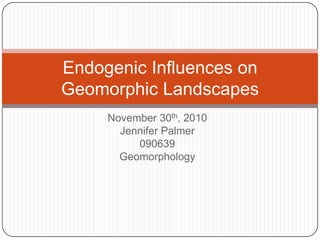
Endogenic influences on geomorphic landscapes
- 1. Endogenic Influences on Geomorphic Landscapes November 30th, 2010 Jennifer Palmer 090639 Geomorphology
- 2. Endogenic Processes Endogenic processes: forces that cause movements beneath the Earth`s surface. Endogenic processes can consist of anything from plate tectonics, earth quakes, and volcanic activities. Endogenic processes occurs so slowly that it is very rare to find an unmodified landform
- 3. Plate Tectonics Convergent boundary- coming together Divergent boundary- pulling apart Transform boundary- two plates that slide horizontally against each other There are 7 plates that cover the earth’s surface and some smaller ones that fit in between the larger ones
- 7. Tectonic Types There are two types of tectonic styles: Orogenic Processes Epeirogenic Processes
- 8. Orogenic Processes Mountain building processes that occur from compressional forces that are generated by continued subduction or the trapping and deformation of sediment and crust between two colliding plates
- 9. Epeirogenic Processes Processes that cause uplift or depression on a regional scale and proceed without internal disruption of original rock surfaces. It occurs in response to driving forces.
- 10. Types of Landforms Created Tectonic scarp Horsts Fault scarp Grabens Thrust-fault scarps Terraces Monoclinal scarps Rift valleys Sag ponds Topographic domes Pressure ridges Fault-block mountain Strike-slip faults Shutter Ridges Detachment faults
- 11. Tectonic Scarp Any steep slope that results from differential movement of the earth’s crust
- 12. Fault Scarp Occurs when a fault displaces the surface of the ground so that one side is higher or lower than the other
- 13. Thrust-fault Scarps Is a major process of upper crustal shortening during orogeny Thrusts upward through sedimentary cover strata and emerge at the land surface
- 14. Monoclinal Scarp Tectonic scarps with height, steepness, and lateral continuity comparable to fault scarps Formed by steep monoclines
- 15. Sag Ponds Found at the foot of recent fault scarps May develop by oblique movement or ground setting
- 16. Pressure Ridges If the pressure on a scarp is compressional They are low elongated mounds that may parallel the surface scarp
- 17. Strike-Slip Fault A fault of any scale along which movement is parallel to the strike of the fault
- 18. Detachment Faults Very large sub horizontal faults at midcrustal depth where the brittle upper mantle has been extended to “highly extended” domains Detachment faults also contain “stable” areas which do not extend nearly as much
- 19. Horsts A fault block that has been uplifted relative to the blocks on either side
- 20. Grabens Depressions produced by subsidence along faults
- 21. Terraces Created by tilting, folding, uplift and faulting
- 22. Rift Valleys Associated with plateaus produced by broad epeirogenic up doming, crustal and lithospheric thinning, profuse volcanism, and high heat flow
- 23. Topographic Domes Are active anticlines or blind thrust faults in rock or sediment
- 24. Fault-block Mountains Occur in mostly arid regions where vegetation is sparse and geological structures are boldly exposed
- 25. Shutter Ridges If a fault crosses gullies or ridges all the spur ends or ridge crests will be displaced in the same direction and will become half-displaced ridges known as shutter ridges
- 26. Volcanism Most volcanic processes are associated with orogenic processes Three main instances where they occur 1. In curved volcanic arcs that probably correspond to early-stage subductive zones 2. In straight volcanic chains within post-tectonic folded mountains 3. In lines of largely extinct volcanoes that formed when lithospheric plates moved over persistent mantle plumes (“hot spots”)
- 27. Hot Spots Hot areas under plates “Hot spots” produce long chains of volcanic islands as the plate travels over them Most “hot spots” are under plate interiors, especially oceanic plates, some are close to divergent plate boundaries and some are near mid-oceanic ridges
